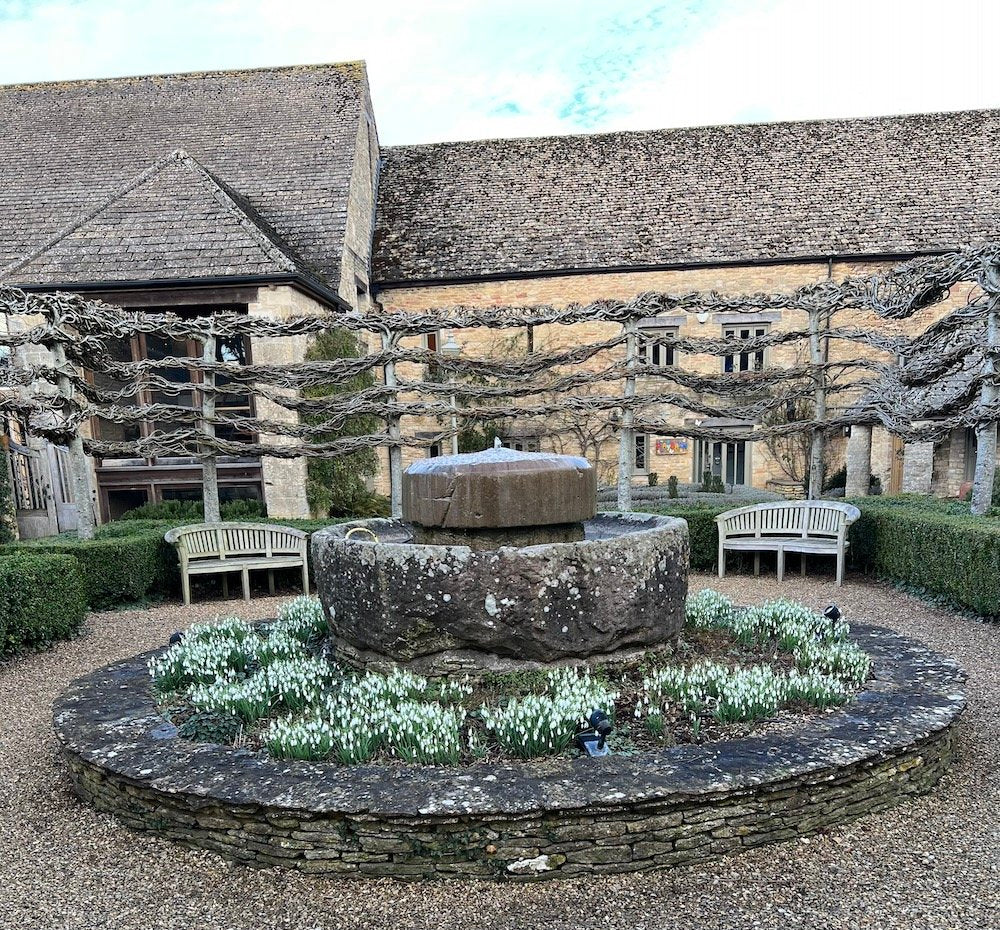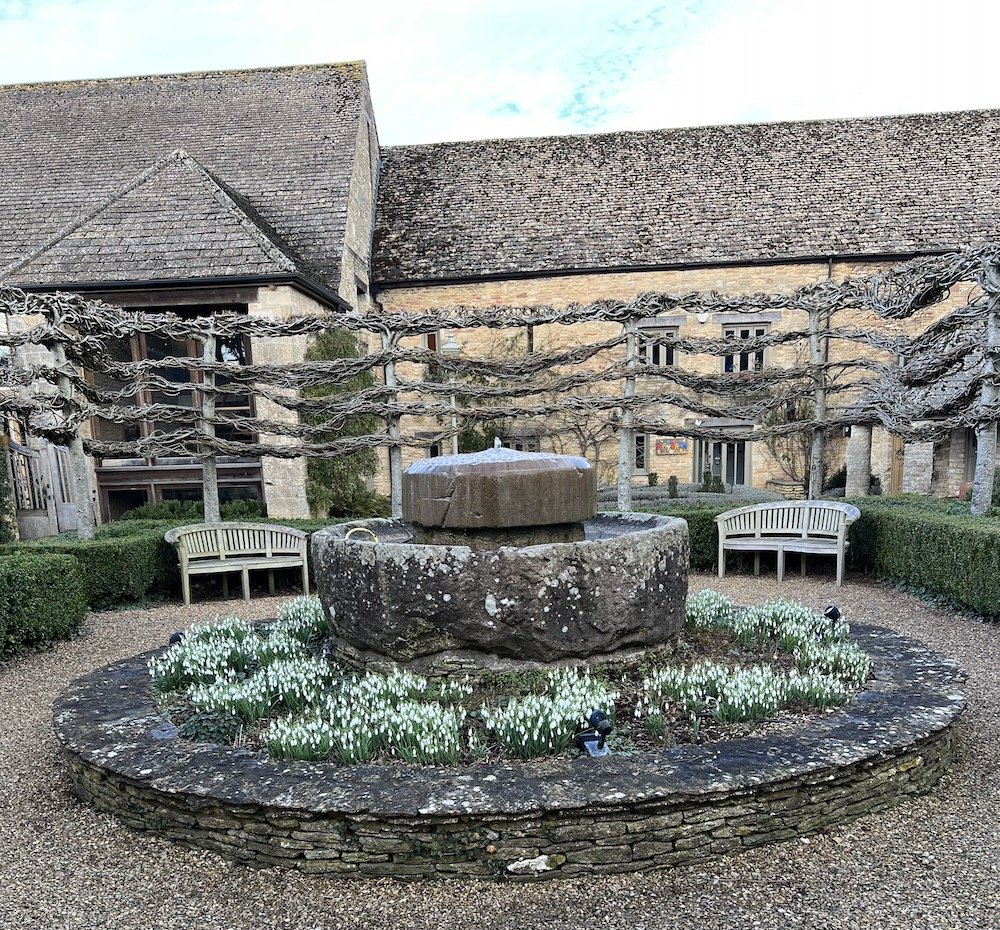
Garden Trends for 2023
SEO Space
Looking forward to Spring; snowdrops at Calcot Manor
It’s now late January and we can look back on a year of turbulent weather patterns which brought to us in the south west a prolonged drought; an exceptionally wet autumn (‘reports of the source of the Thames moving downstream are greatly exaggerated’ to misquote Mark Twain) and two prolonged spells of intense cold which have tried and found wanting a number of marginally hardy plants in the garden.
Looking at the predictions of many of our most respected gardeners and garden designers, I feel I must urge some caution. Climate change and sustainability continue to dominate the conversation with a focus on resilient planting, recycled materials and minimal human impact but the advice to plan for Mediterranean style gardens does not fit with the water standing in the courtyard garden for weeks; the Thames in full spate or the cold temperatures that robbed my olives, pittisporums and bays of all leaf cover – will they come back in spring?

Snow blanketed the ground for a week in December

The Thames in spate a few weeks ago
Harry Holding wisely urges us to choose plants that can adapt to new weather patterns, plants that can adapt to both droughts and the UK’s winter wet and I cannot argue with Matthew Child’s advice to reconnect with nature; to support wildlife and to do our bit to heal the environment and, finally, to choose plants that are more about reliability than conforming to a stereotype – a theme echoed by many designers.
However, I return, as always, to that most elegant and eloquent of garden writers, Robin Lane-Fox who cautions against rewilding: ’… Long-lost orchids and violets were supposedly longing to burst into flower beneath our lawns. Most of us would have been graced with nettles, ground-elder and bindweed if we had given up gardening’. His guidelines are based on years of trial and error and still hold good:

A raised cutting bed is filled with good quality topsoil before planting
-
Soil teaches hard lessons. Very few of us have first class topsoil (although raised beds are the ideal place for this luxury). Incorporating organic matter every season will improve your soil enormously but learn about your soil and adapt your planting to suit it. I love Hamamelis mollis, the witch hazel, but it hates my heavy clay and after years of looking at weedy growth and lack of flowers I have sent it to Devon where it will thrive on my brother’s acid soil.
-
Spacing: we plant too closely; planners and designers have accustomed us to borders with far too many plants. Plan for the long term allowing each plant room to reach its ultimate height – three to five plants per square yard was a rule of thumb 50 years ago and remains good today unless you are prepared to move plants each season
-
Height gives a garden fine lines and points of emphasis. Delphiniums and foxgloves are perennial favourites for punctuating a border but I also love to use several tall frames, such as Cotswold obelisks or Rose cages to break up the lower planting
-
Colour is a matter of personal choice and can be planned to change with the seasons – who minds a clashing profusion of colours in spring after the drab shades of winter? I have always tended towards a subdued palette of lavender blue and creamy white with a range of greens, but I do enjoy punches of orange or purple that catch the eye and brightly coloured borders as long as there is space for the eyes to rest between the competing hues. Remember, though, that with our changing seasons carefully matched neighbours may well flower out of season and miss one another!
And, finally, what might we expect to see at Chelsea this year?
The main attraction for many visitors to Chelsea is the gardens on Main Avenue, intended to be the show-stopping centrepiece for the best of our garden designers. One trend that we can expect to see coming through even more strongly is the emphasis on wildlife, sustainability and minimising human impact; on less manicured spaces; on the use of native plants and a move towards self-sufficiency.
Last year, in my Chelsea round up, I reported on the final discussions between Jo Swift and Monty Don on the subject of: ‘is it a garden or is it a landscape?’ and I agree with those experts that this is a topic that the RHS needs to address. Despite our love of the glorious countryside that surrounds us and our growing environmental awareness and belief in organic growing, we still, I think, want space for the quiet and calm of a traditional garden. Quintessential English gardens, developed over many years by influential gardeners such as Gertrude Jekyll, Beth Chatto and Marjorie Fish with their exquisite planting and focus on the right plant for the right place, still provide balm for the soul.
A number of show gardens have already been announced and the theme of health and wellbeing is already very clear; gardens are seen more and more as an extension of our homes and places where we play our own small part in looking after our own health as well caring for the natural world. Among them are:
-
The Royal Entomological Society Garden designed by Chelsea Gold medal winner Tom Massey is inspired by the rich biodiversity found on brownfield sites, areas of wasteland that are highly beneficial to insect life
-
We are staunch supporters of the charity Horatio’s Garden and this year two of our foremost designers, Charlotte Harris and Hugo Bugg, have planned a wheelchair accessible garden for patients recovering from spinal injury. The garden focuses on the evidence-based needs of those in long term hospital settings, providing a beautiful space away from clinical settings which supports their recovery
-
Korean designer Jihae Hwang highlights how a rewilding project in her home country has helped prevent native plants from becoming extinct. Land of Healing: Korean Mountain Light garden promotes balanced ecosystems found around the Jiri Mountain region, which grows more than 1,000 native medicinal plants
Increasingly diverse and popular are the other categories of smaller garden that line the boundaries of the show and, again, we see gardens that showcase an awareness of our fragile environment as well as an extension of our homes as key themes:
-
The Savills Garden by Mark Gregory, champions how growing your own food can form the basis of a healthy lifestyle
-
The Nature Landscapes Garden by Sarah Price, is a low carbon garden
-
Hampton’s Mediterannean Garden by Filippo Dester will transport visitors to a contemporary outdoor living space, combining a kitchen and entertainment area surrounded by edible and fragrant planting
-
Animals have their own sanctuary with the RSPCA’s wildlife-friendly garden by first-time Chelsea designer Martyn Wilson, creating a space for both humans and creatures to live in harmony.
In a future journal, we will be celebrating the lives of some of the women designers that have shaped our vision of gardens.






